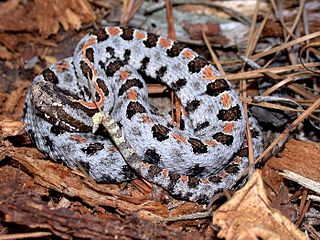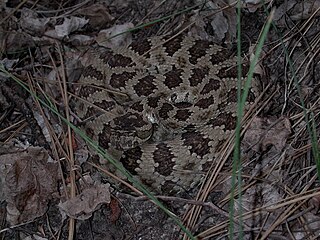
Agkistrodon contortrix is a species of venomous snake, a pit viper, endemic to Eastern North America; it is a member of the subfamily Crotalinae in the family Viperidae. The generic name is derived from the Greek words ancistro (hooked) and odon (tooth), and the specific name comes from the Latin contortus ; thus, the scientific name translates into "twisted hook-tooth". The common name for this species is the copperhead. Its behavior may lead to accidental encounters with humans. Five subspecies are currently recognized, including the nominate subspecies described here.

Crotalus is a genus of venomous pit vipers in the family Viperidae, known as rattlesnakes or rattlers. The genus is found only in the Americas from southern Canada to northern Argentina, and member species are colloquially known as rattlesnakes. The generic name Crotalus is derived from the Greek word κρόταλον krótalοn, which means "rattle" or "castanet", and refers to the rattle on the end of the tail which makes this group so distinctive. Currently, 32 to 45 species are recognized as being valid.

Sistrurus is a genus of venomous pit vipers in the subfamily Crotalinae of the family Viperidae. The genus is endemic to Canada, the United States, and Mexico. The generic name is a Latinized form of the Greek word for "tail rattler" and shares its root with the ancient Egyptian musical instrument, the sistrum, a type of rattle. Three species are currently recognized.

The massasauga is a rattlesnake species found in midwestern North America from southern Ontario to northern Mexico and parts of the United States in between. Three subspecies are currently recognized including the nominate subspecies described here. Like all rattlesnakes, it is a pit viper, and like all pit vipers, it is venomous.

The timber rattlesnake, canebrake rattlesnake or banded rattlesnake, is a species of venomous pit viper endemic to eastern North America. This is the only rattlesnake species in most of the populous northeastern United States and is second only to its cousins to the west, the prairie rattlesnake, as the most northerly distributed venomous snake in North America. No subspecies are currently recognized.

Pantherophis gloydi, commonly known as the eastern foxsnake or eastern fox snake, is a species of rat snake in the family Colubridae. The species is nonvenomous and is endemic to the eastern Great Lakes region of the United States, as well as adjacent western Ontario in Canada. Pantherophis gloydi is sometimes considered a distinct species and sometimes considered a junior synonym of the species Pantherophis vulpinus.

Agkistrodon piscivorus leucostoma is a venomous snake that is endemic to the south central United States. A member of the subfamily Crotalinae of the family Viperidae, it is the smallest of the three subspecies of Agkistrodon piscivorus.

Crotalus viridis is a venomous pit viper species native to the western United States, southwestern Canada, and northern Mexico. Currently, two subspecies are recognized, including the nominate subspecies described here.

Sistrurus miliarius, commonly called the pygmy rattlesnake, is a species of venomous snake in the subfamily Crotalinae of the family Viperidae. The species is endemic to the Southeastern United States. Three subspecies are currently recognized, including the nominate subspecies described here.

Agkistrodon piscivorus conanti, commonly known as the Florida cottonmouth or green-tailed moccasin, is a venomous pitviper subspecies in the family Viperidae. The subspecies is found in the southeastern United States, particularly in Florida.

Sistrurus catenatus tergeminus is a venomous pit viper subspecies found in the southwestern plains of the United States. In some areas its range overlaps that of another subspecies, S. c. edwardsii, and intergrading of the two is not unknown.

Sistrurus catenatus edwardsii is a subspecies of venomous pit viper in the family Viperidae. The subspecies is endemic to the southwestern United States and northern Mexico. In places its range overlaps that of S. c. tergeminus, and intergrading of the two subspecies is known.

Crotalus oreganus abyssus is a venomous pit viper subspecies found only in the U.S. states of Arizona and Utah.

Sistrurus miliarius barbouri is a venomous pit viper subspecies endemic to the southeastern United States.

Crotalus lutosus is a venomous pit viper species found in the Great Basin region of the United States.

Crotalus pricei is a species of venomous snake, a pit viper in the family Viperidae. The species is endemic to the southwestern United States and northern Mexico. Two subspecies are recognized, including the nominate subspecies described here.

Agkistrodon contortrix mokasen is a venomous pit viper subspecies found in the eastern United States.
Hypnale walli, or Wall's hump-nosed viper, is a venomous pitviper species endemic to Sri Lanka. The smallest member of its genus, it is distinguished by having a strongly upturned nose and lower scale counts. No subspecies are currently recognized.
Gloydius intermedius is a venomous pitviper species endemic to northern Asia. Three subspecies are currently recognized, including the nominate subspecies described here.
Gloydius brevicaudus is a venomous pitviper subspecies endemic to China and the Korean Peninsula.
















